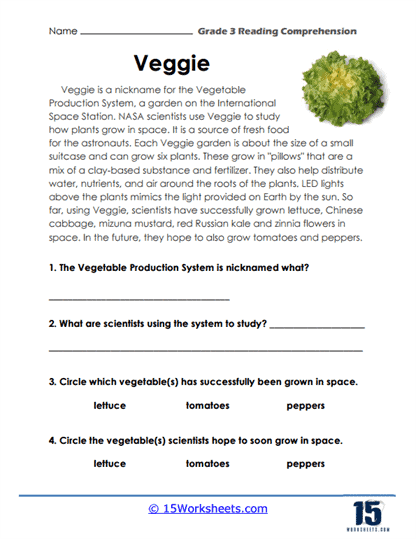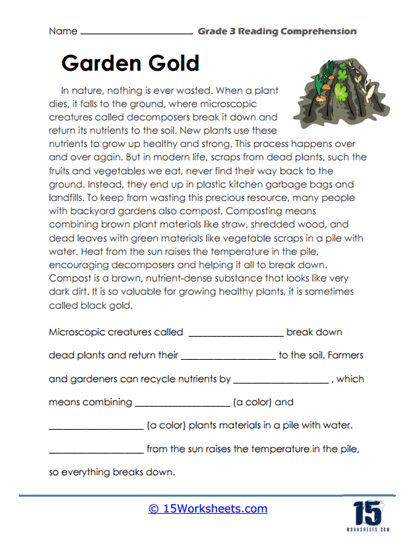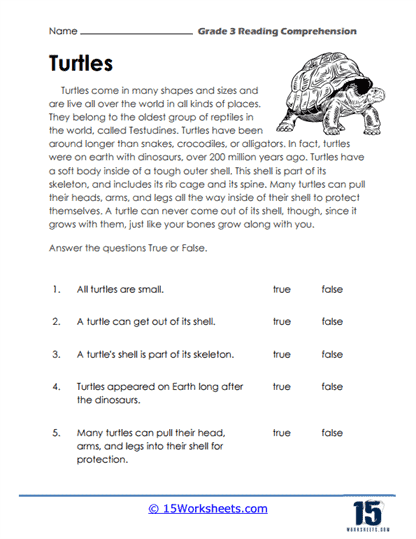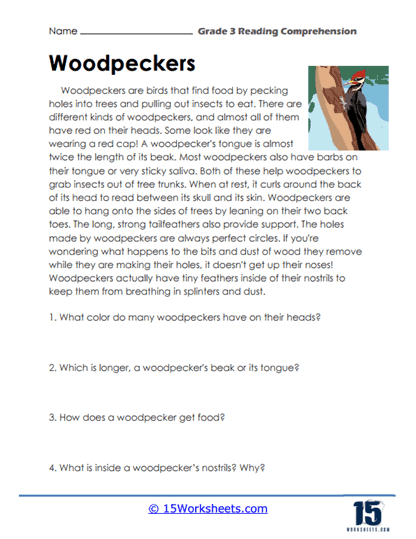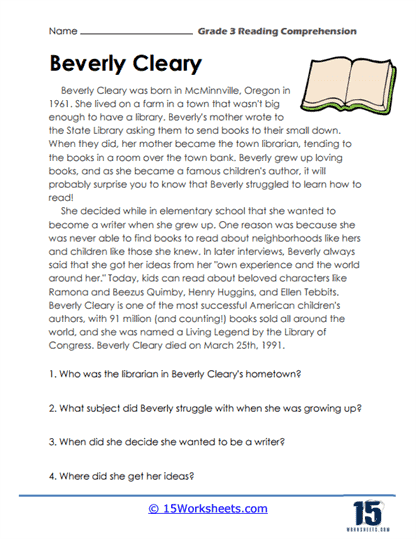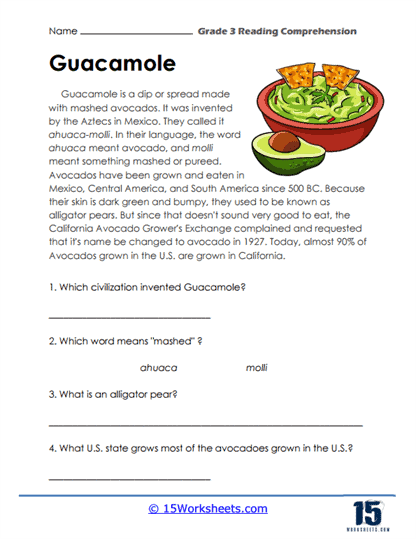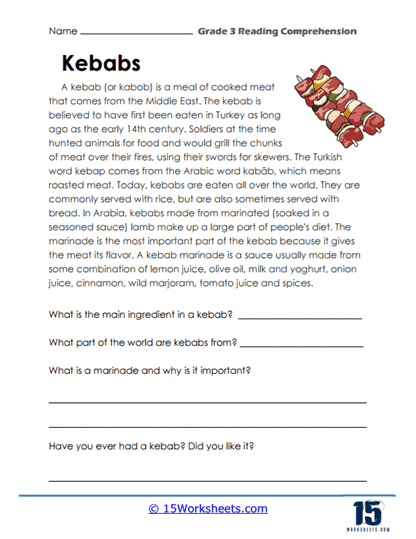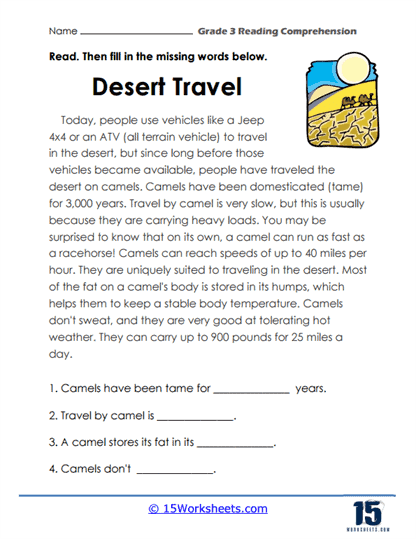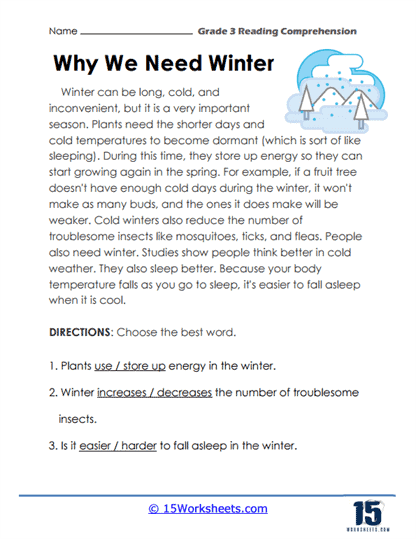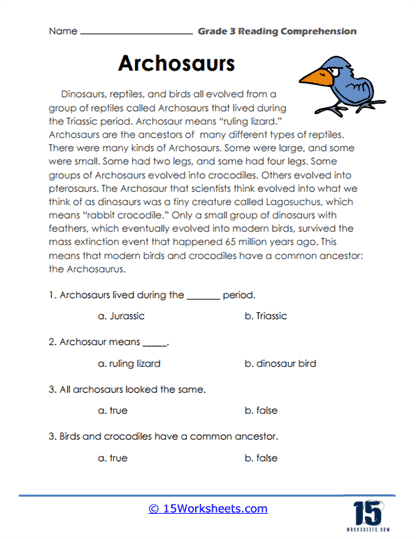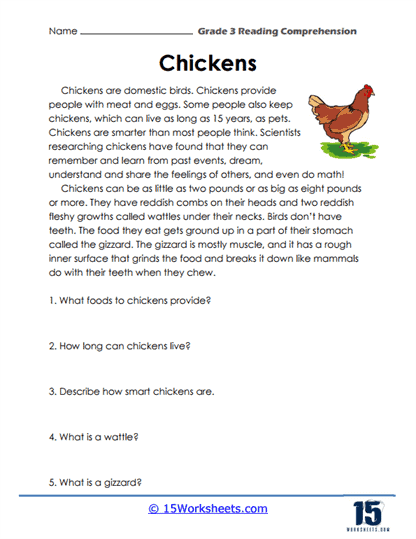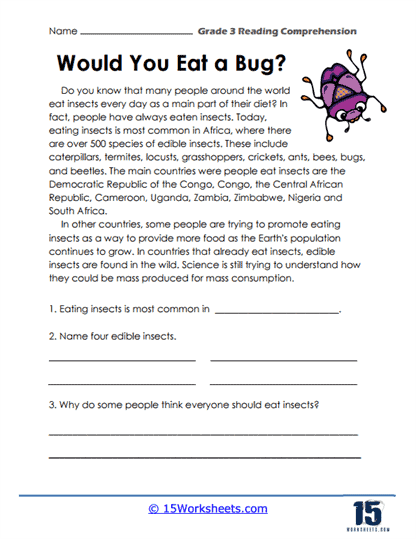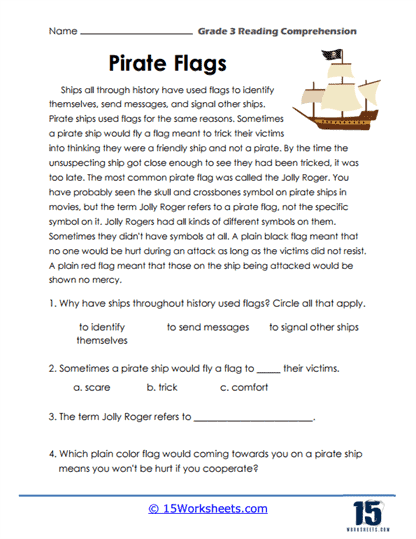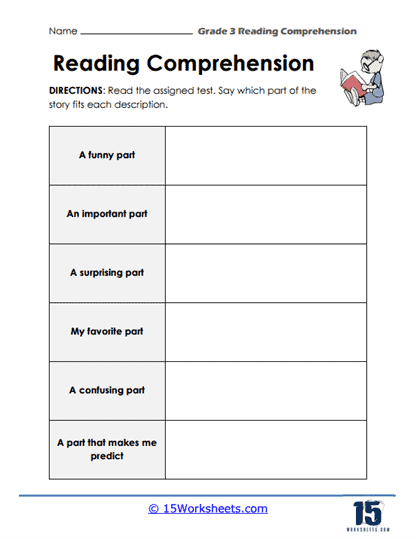Grade 3 Reading Comprehension Worksheets
All About These 15 Worksheets
Grade 3 Reading Comprehension Worksheets were created to help 3rd grade students practice and improve their reading comprehension skills. These worksheets include longer and more complex passages of text followed by a series of questions that assess the reader’s understanding of the material.
A grade 3 student should be able to read fluently and with expression, adjusting their pace based on the type and complexity of the text. They should have a growing vocabulary, allowing them to understand the meaning of unfamiliar words using context clues and prefixes or suffixes. Comprehension is key; students should identify the main idea, supporting details, and distinguish fact from opinion in a text. They should also be able to make connections between texts, comparing and contrasting themes, characters, or events. Critical thinking should emerge as they begin to infer deeper meanings, identify cause-and-effect relationships, and recognize an author’s point of view. Lastly, they should engage with diverse genres, recognizing the unique characteristics of fiction, non-fiction, poetry, and informational texts.
Imagine that reading is like going on a treasure hunt. When you read, you are searching for knowledge, ideas, or stories buried in the words on the page. The treasure you find can be exciting, like a new adventure in a fictional story, or it can be valuable, like learning a new fact in a non-fiction book. But to get the treasure, you have to understand what the words and sentences are trying to say. This understanding is what we call reading comprehension.
They typically contain short passages, both fiction and non-fiction, that third-grade students are expected to be able to read. The passages are written on various topics like animals, outer space, historical events, or maybe even about everyday situations.
Following these passages, there are usually a series of questions that ask about what you’ve just read. The questions could ask about the main idea, the details, or the sequence of events in the story. Sometimes, there might also be questions asking you to predict what will happen next, or to infer something that wasn’t directly stated in the passage.
These worksheets are pretty important because they help in several ways. Firstly, they improve vocabulary. Reading passages expose kids to new words, which expand their word bank. Secondly, they enhance critical thinking skills. Answering questions about what you’ve just read requires you to think critically about the text. Lastly, these worksheets improve the speed and accuracy of reading because the more you practice, the better and faster you get at reading.
Remember when we talked about reading being like a treasure hunt? Well, the questions on the worksheets are like your treasure map. They guide you to look for specific details in the text, and by doing so, they help you understand the passage better. So, every time you read a passage and answer the questions correctly, you’ve found the treasure!
How Can 3rd Graders Improve Their Reading Skills?
Improving reading skills in 3rd graders involves a combination of targeted practice, engaging activities, and support from teachers, parents, or caregivers. Here are some strategies to help 3rd graders improve their reading skills:
Encourage Daily Reading – Set aside a specific time each day for reading, and make it a routine. This can be independent reading, shared reading with an adult, or even listening to audiobooks.
Choose Age-appropriate and Diverse Materials – Select a variety of books, articles, and stories that match the child’s reading level and interests. Introduce different genres, themes, and cultures to keep reading engaging and enjoyable.
Practice Reading Aloud – Reading aloud helps improve fluency, expression, and comprehension. Encourage the child to read aloud, and take turns reading to each other to make it a fun and interactive activity.
Discuss the Text – After reading, engage the child in a conversation about the story. Ask open-ended questions that promote critical thinking and comprehension, such as “What did you learn from the story?” or “How did the characters change?”
Develop Vocabulary – Introduce new words and phrases in context and help the child understand their meanings. Encourage them to use new words in their conversations and writing.
Use Graphic Organizers – Visual tools like Venn diagrams, story maps, and sequence charts can help children organize their thoughts and better understand the text.
Teach Reading Strategies – Teach the child strategies like summarizing, predicting, visualizing, and making connections to improve their comprehension skills.
Provide a Supportive Environment – Create a comfortable and quiet space for reading, and be patient and positive when offering guidance or feedback.
Monitor Progress – Regularly assess the child’s reading progress through informal observations, quizzes, or discussions. Offer feedback and adjust instruction as needed.
Collaborate with Educators – Stay in close communication with the child’s teacher to understand their strengths and areas of improvement, and work together to develop a plan to support their reading development.
What Reading Skills Do 3rd Graders Learn?
Third grade is a pivotal year for students in terms of reading. In fact, it’s often said that up until third grade, students are learning to read, but starting in third grade, they are reading to learn. Here are some key reading skills that students in third grade are expected to master:
Fluency – Fluency is the ability to read a text accurately, quickly, and with expression. By the end of third grade, students are expected to read grade-level text with purpose and understanding, and with appropriate pacing, intonation, and expression. They should be able to use context to confirm or self-correct word recognition and understanding, rereading as necessary.
Comprehension – Comprehension skills become more complex in third grade. Students should be able to answer questions to demonstrate understanding of a text, referring explicitly to the text as the basis for the answers. They will be expected to retell stories and recount details, and should be able to determine the main idea of a text and explain how it is supported by key details. They should also be able to describe characters in a story and explain how their actions contribute to the sequence of events.
Decoding and Phonics – By third grade, students are expected to have a good command of more advanced phonics rules. They should be able to identify and know the meaning of common prefixes and suffixes, and be able to decode words with those prefixes and suffixes. They should also be able to decode multisyllable words.
Vocabulary – In terms of vocabulary, third graders should be able to determine or clarify the meaning of unknown and multiple-meaning word and phrases based on grade 3 reading and content. They should be choosing flexibly from a range of strategies such as using sentence-level context as a clue to the meaning of a word or phrase, using glossaries or beginning dictionaries, both print and digital, to determine or clarify the precise meaning of key words and phrases.
Text Analysis – Third graders begin to analyze text more deeply. They should be able to distinguish their own point of view from that of the narrator or those of the characters. They should also be able to explain how specific aspects of a text’s illustrations contribute to what is conveyed by the words in a story (e.g., create mood, emphasize aspects of a character or setting).
Reading Different Types of Text – By the end of third grade, students should be comfortable reading and understanding different types of text, including fiction, non-fiction, and poetry. They should be able to compare and contrast the themes, settings, and plots of stories written by the same author about the same or similar characters.
By the end of third grade, students should have these core reading skills well in hand, as they form the basis for more advanced reading and comprehension in the grades to come.
Overall, this is not just a collection of worksheets; it is a comprehensive resource that empowers third-grade students to develop strong reading comprehension skills, setting them on a path towards academic excellence and a lifelong love for reading.
By nurturing critical thinking, vocabulary growth, and a deep connection with literature, this collection equips students with the tools they need to excel in their studies and become avid, capable readers
This series of 15 worksheets underscores the enduring importance of reading comprehension as a foundation for lifelong learning and success, making it an invaluable asset for educators, parents, and young learners alike.

